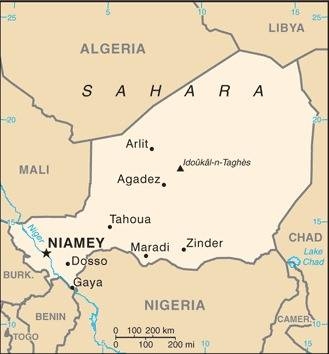Country Summary




Introduction
Background
Niger became independent from France in 1960. It is one of the poorest countries in the world with insufficient funds to develop its resource base. The largely agrarian and subsistence-based economy is frequently disrupted by extended droughts common to the Sahel region of Africa.
Geography
Area
total: 1.267 million sq km
land: 1,266,700 sq km
water: 300 sq km
Climate
desert; mostly hot, dry, dusty; tropical in extreme south
Natural resources
uranium, coal, iron ore, tin, phosphates, gold, molybdenum, gypsum, salt, petroleum
People and Society
Population
24,484,587 (2022 est.)
Ethnic groups
Hausa 53.1%, Zarma/Songhai 21.2%, Tuareg 11%, Fulani (Peuhl) 6.5%, Kanuri 5.9%, Gurma 0.8%, Arab 0.4%, Tubu 0.4%, other/unavailable 0.9% (2006 est.)
Languages
French (official), Hausa, Djerma
Religions
Muslim 99.3%, Christian 0.3%, animist 0.2%, none 0.1% (2012 est.)
Population growth rate
3.66% (2022 est.)
Government
Government type
semi-presidential republic
Capital
name: Niamey
Executive branch
chief of state: President Mohamed BAZOUM (since 2 April 2021)
head of government: Prime Minister Ouhoumoudou MAHAMADOU (since 3 April 2021)
Legislative branch
description: unicameral National Assembly or Assemblee Nationale (171 statutory seats - 166 currently; 158 members directly elected from 8 multi-member constituencies in 7 regions and Niamey by party-list proportional representation, 8 reserved for minorities elected in special single-seat constituencies by simple majority vote, 5 seats reserved for Nigeriens living abroad - l seat per continent - elected in single-seat constituencies by simple majority vote; members serve 5-year terms)
Economy
Economic overview
low-income Sahel economy; major instability and humanitarian crises limit economic activity; COVID-19 eliminated recent antipoverty gains; economy rebounding since December 2020 Nigerian border reopening and new investments; uranium resource rich
Real GDP (purchasing power parity)
$28.97 billion (2020 est.)
Real GDP per capita
$1,200 (2020 est.)
Agricultural products
millet, cow peas, sorghum, onions, milk, groundnuts, cassava, cabbages, goat milk, fruit
Industries
uranium mining, petroleum, cement, brick, soap, textiles, food processing, chemicals, slaughterhouses
Exports
$1.39 billion (2019 est.)
Exports - partners
United Arab Emirates 54%, China 25%, France 7%, Pakistan 5% (2019)
Exports - commodities
gold, sesame seeds, uranium, natural gas, refined petroleum (2019)
Imports
$3.4 billion (2019 est.)
Imports - partners
China 19%, France 9%, United Arab Emirates 7%, Cote d'Ivoire 6%, India 6%, Nigeria 5%, Togo 5%, Turkey 5% (2019)
Imports - commodities
rice, packaged medicines, palm oil, cars, cement (2019)
Exchange rates
Communaute Financiere Africaine francs (XOF) per US dollar -
Page last updated: Thursday, July 28, 2022
